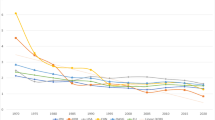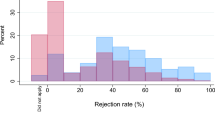Abstract
We address the issue of differentiation of the profile of universities and offer a set of new indicators based on microdata at the individual level and the application of robust nonparametric efficiency measures.
In particular, we use efficiency measures in order to characterize the way in which universities use their inputs (academic and non academic staff, funding) in the effort to position themselves in the space of output (undergraduate teaching, postgraduate education, fundamental research, contract research, third mission), while keeping efficiency under control.
The strategic problem of universities is defined as making best use of existing resources in the short run, while enlarging the scope of autonomy in procuring additional resources in the long run. In order to make best use of resources universities are led to increase their specialization and differentiate their offering profile. This happens even if the European institutional landscape does not encourage universities to differentiate.
Similar content being viewed by others
References
Amaral, A., Jones, G. A., Karseth, B. (Eds) (2002), Governing Higher Education: National Perspectives on Institutional Governance. Dordrecht, Kluwer Academic Publishers.
Barré, R. (2006), Towards a European STI Indicators Platform (ESTIP), Position Paper presented at the second PRIME annual conference, Paris, February 2006.
Bonaccorsi, A. (2007), Explaining poor performance of European science: Institutions versus policies, Science and Public Policy, 34(5): 303–316.
Bonaccorsi, A., Daraio, C. (2004), Econometric approaches to the analysis of productivity of R&D systems. Production functions and production frontiers, In: H. F. Moed, W. Glänzel, U. Schmoch (Eds), Handbook of Quantitative Science and Technology Research, Kluwer Academic Publishers, pp. 51–74.
Bonaccorsi, A., Daraio, C. (Eds) (2007a), Universities and Strategic Knowledge Creation. Specialisation and Performance in Europe, Cheltenham, Edward Elgar.
Bonaccorsi, A., Daraio, C. (2007b), Theoretical perspectives on university strategy, In: Bonaccorsi & Daraio (2007a).
Bonaccorsi, A., Daraio, C. (2007c), Universities as strategic knowledge creators: Some empirical evidence, In: [Bonaccorsi & Daraio, 2007a].
Bonaccorsi, A., Daraio, C., Lepori, B., Slipersaeter, S. (2007d), Indicators on individual higher education institutions: Addressing data problems and comparability issues, Research Evaluation, 16(2): 66–78.
Bonaccorsi, A., Daraio, C., Simar., L. (2006), Size, scope and trade-off in the productivity of universities: an application of robust nonparametric methods to Italian data. Scientometrics, 66(2): 389–410.
Bonaccorsi, A., Daraio, C., Simar, L. (2007), Productivity and efficiency of European universities. Exploring trade-offs in the strategic profile, In: [Bonaccorsi & Daraio, 2007a].
Cazals, C., Florens, J.P., Simar, L. (2002), Nonparametric frontier estimation: a robust approach, Journal of Econometrics, 106: 1–25.
Clark, B. R. (1983), The Higher Education System: Academic Organization in Cross-National Perspective. Berkeley, The University of California Press.
Crespi, G. (2007), The UK knowledge production function, In: [Bonaccorsi & Daraio, 2007a].
D’Angelo, C. A., Pugini, F., Abramo, G. (2006), La misurazione della produttività scientifica delle università italiane attraverso una metodologia bibliometrica-non parametrica, In: Reti, servizi e competitività delle imprese, XVII Riunione Scientifica AiIG, Aracne Roma.
Daraio, C., Simar, L. (2005), Introducing environmental variables in nonparametric frontier models: A probabilistic approach, Journal of Productivity Analysis, 24(1): 93–121.
Daraio, C., Simar, L. (2007), Advanced Robust and Nonparametric Methods in Efficiency Analysis. Methodology and Applications. New York, Springer.
Ehrenberg, R. G. (2004), Econometric studies of higher education, Journal of Econometrics, 121: 19–37.
Esterle, L., Theves, J. (2005), Analysis of the different European systems for producing indicators, paper presented at the Lisbon Workshop on S&T Indicators Production, Lisbon 22–23 September 2005.
European Commission (2003), Third European Report on Science & Technology Indicators. Brussels, European Commission.
Evidence Ltd (2006), The Quality Base of UK Science. Mimeo, June.
Filippini, M., Lepori, B. (2007), Cost structure, economies of capacity utilization and scope in Swiss Higher education institutions, In: [Bonaccorsi & Daraio, 2007a].
Godin, B. (2005), Measurement and Statistics on Science and Technology: 1920 to the Present. London, Routledge.
Griliches, Z. (1994), Productivity, R&D, and the data constraint, American Economic Review, 84(1): 1–23.
Hicks, D. (2004), The four literatures of social science, In: [Moed & al., 2004: 473–496].
Huisman, J., Kaiser, F. (Eds) (2001), Fixed and Fuzzy Boundaries in Higher Education. A Comparative Study of (Binary) Structures in Nine Countries. Den Haag, Adviesraad voor het Wetenschapsen.
Jongbloed, B., Lepori, B., Salerno, C., Slipersaeter, S. (2005), European Higher Education Institutions: Building a Typology of Research, CHINC report, IPTS, Seville.
King, D. (2004), The scientific impact of nations. What different countries get for their research spending, Nature, 430: 311–316.
Kyvik, S. (2004), Structural changes in Higher Education systems in Western Europe. Higher Education in Europe, 29(3): 393–409.
Kyvik, S., Skovdin, O.-J. (2003), Research in the non-university higher education sector-tensions and dilemmas. Higher Education, 45: 203–222.
Laredo, P. (Ed.) (2003), Observatoire Recherche Angevine. Sinthèse Enquete 2002. Paris, Technopolis France.
Lepori, B., Benninghoff, M., Jongbloed, B., Salerno, C., Slipersaeter, S. (2007), Changing models and patterns of higher education funding: some empirical evidence. In: [Bonaccorsi & Daraio, 2007A].
Marchetti, C. (1989), The Nobel saga, Technology Review, Italian edition, March.
Marsh, L. C. (2004), The econometrics of Higher Education: editor’s view, Journal of Econometrics, 121: 1–18.
McCormick, A. C. (2004), The 2005 revision of the Carnegie Classification System. Presentation to the Washington Higher Education Secretariat. Washington D.C. June 8, 2004. Available online at: http://www.carnegiefoundation.org/Classification/future.htm
Musselin, C. (2004), Towards a European academic labor market? Some lessons drawn from empirical studies on academic mobility. Higher Education, 48: 55–78.
Musselin, C. (2005), Le Marché des Universitaires. France, Allemagne, Etats-Unis. Paris, Presses de la Fondation National des Sciences Politiques.
Neave, G., Van Vught, F. A. (1994), Government and Higher Education Relationships Across Three Continents. Oxford, Pergamon Press.
Slipersaeter, S. (2005), Comparisons of methodological approaches for determining research intensity at higher education institutions, paper presented at the Lisbon Workshop on S&T Indicators Production, Lisbon 22–23 September 2005.
Slipersaeter, S., Lepori, B., Jongbloed, B., Salerno, C. (2005), Collecting Institutional Level Data for European Higher Education Institutions: Evidence from the CHINC Project, CHINC report.
Author information
Authors and Affiliations
Corresponding author
Rights and permissions
About this article
Cite this article
Bonaccorsi, A., Daraio, C. The differentiation of the strategic profile of higher education institutions. New positioning indicators based on microdata. Scientometrics 74, 15–37 (2008). https://doi.org/10.1007/s11192-008-0101-8
Received:
Published:
Issue Date:
DOI: https://doi.org/10.1007/s11192-008-0101-8




